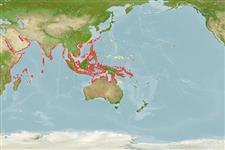>
Eupercaria/misc (Various families in series Eupercaria) >
Lutjanidae (Snappers) > Lutjaninae
Etymology: Lutjanus: Malay, ikan lutjan, name of a fish.
Eponymy: Dr Christian Gottfried Ehrenberg (1795–1876) was a German naturalist, comparative anatomist and microscopist; one of the foremost scientists of his time. [...] (Ref. 128868), visit book page.
More on author: Peters.
Environment: milieu / climate zone / ລະດັບຄວາມເລິກ / distribution range
ນິເວດວິທະຍາ
ສັດທະເລ; ນ້ຳຈືດ; ນ້ຳກ່ອຍ ກ່ຽວກັນຫີນ; ລະດັບຄວາມເລິກ 5 - 20 m (Ref. 9710). Tropical; 30°N - 18°S, 31°E - 165°E (Ref. 55)
Indo-West Pacific: Red Sea and East Africa to the Solomon and Mariana islands.
Length at first maturity / ຂະໜາດ / ນ້ຳໜັກ / Age
ການຈະເລີນເຕັມໄວ: Lm 20.1, range 12 - ? cm
Max length : 35.0 cm TL ຕົວຜູ້/ບໍ່ມີເພດ; (Ref. 55); common length : 20.0 cm TL ຕົວຜູ້/ບໍ່ມີເພດ; (Ref. 55)
ຄີ (ໜາມ)ແຂງຢູ່ຫຼັງປາ (ທັງໝົດ) : 10; ຄີຫຼັງຂອງປາ (ຄີອ່ອນ) (ທັງໝົດ) : 13 - 14; ຄີ(ໜາມ) ແຂງຢູ່ຄີກົ້ນປາ
ກຸ່ມປາກະດູກແຂງ
ຄວາມຖີ່ຂອງກຸ່ມຖ່າຍທອດພັນ
ປາທີ່ມີການເຄື່ອນຍ້າຍຈາກທະເລໄປຫານ້ຳຈືດ ແລະນ້ຳຈືດຫາທະເລ
ປາທີ່ມີການເຄື່ອນຍ້າຍຈາກທະເລແລະໄປໄຂ່ຢູ່ນ້ຳຈືດ
ຄີກົ້ນຂອງປາ
ສັດທີ່ມີກະດູກສັນຫັຼງ
ການຖ່າຍທອດທາງກຳມະພັນຈາກພໍ່ແມ່ຫາລູກ: 3; ຄີກົ້ນຂອງປາ: 7 - 9. This species is distinguished by the following characters: body moderately deep; greatest depth 2.5-3.0 in SL; preopercular notch and knob poorly developed; vomerine tooth patch triangular, with a medial posterior extension; gill rakers of first gill arch 6-7 + 10-14 - 16-21; caudal fin truncate to slightly emarginate; scale rows on back parallel to lateral line. Colour of back and upper sides dark brown, lower sides and belly whitish with a silver sheen; usually a series of 4-5 narrow yellow stripes on the sides below the lateral line; a distinct round, black spot on the back below the posterior part of the spinous portion of the dorsal fin (Ref. 9821, 90102).
Body shape (shape guide): fusiform / normal; Cross section: oval.
Adults inhabit very shallow coastal habitats, often in large schools near freshwater run-offs (Ref. 48635). Juveniles often intertidal (Ref. 48635); over sand, silt, or coral rubble bottoms, occasionally in mangrove-lined streams and estuaries (Ref. 9821) They may enter freshwater to feed (Ref. 245); on small fish and invertebrates (Ref. 5213). This is a small species commonly utilized in subsistence fisheries and also seen in markets. Caught mainly with handlines, traps, and gill nets and are marketed mostly fresh (Ref. 9821).
Life cycle and mating behavior
ການຈະເລີນເຕັມໄວ | ການສືບພັນ | ການວາງໄຂ່ | ໄຂ່ | ຄວາມດົກຂອງໄຂ່ປາ | ຕົວອ່ອນ
Allen, G.R., 1985. FAO Species Catalogue. Vol. 6. Snappers of the world. An annotated and illustrated catalogue of lutjanid species known to date. FAO Fish. Synop. 125(6):208 p. Rome: FAO. (Ref. 55)
IUCN Red List Status (Ref. 130435: Version 2025-1)
Threat to humans
Harmless
Human uses
ການປະມົງ: ທີ່ເປັນການຄ້າໜ້ອຍ
ເຄື່ອງມື
Special reports
Download XML
ແຫຼ່ງອີນເຕີເນັດ
Estimates based on models
Preferred temperature (ເອກະສານອ້າງອີງ
123201): 25.9 - 29.3, mean 28.6 °C (based on 2891 cells).
Phylogenetic diversity index (ເອກະສານອ້າງອີງ
82804): PD
50 = 0.5000 [Uniqueness, from 0.5 = low to 2.0 = high].
Bayesian length-weight: a=0.01622 (0.01038 - 0.02533), b=2.95 (2.83 - 3.07), in cm total length, based on LWR estimates for this species & Genus-body shape (Ref.
93245).
ຊັ້ນເຂດຮ້ອນ (ເອກະສານອ້າງອີງ
69278): 3.6 ±0.53 se; based on food items.
Generation time: 4.4 ( na - na) years. Estimated as median ln(3)/K based on 2
growth studies.
ຄວາມຢືດຢຸ່ນ (ເອກະສານອ້າງອີງ
120179): ສູງ, ປະຊາກອນຕຳ່ສຸດທີ່ໃຊ້ເວລາສອງໜ້ອຍກວ່າ 15 ເດືອນ (Preliminary K or Fecundity.).
Fishing Vulnerability (Ref.
59153): Low vulnerability (19 of 100).
🛈
Nutrients (Ref.
124155): Calcium = 56.1 [33.6, 96.4] mg/100g; Iron = 0.49 [0.30, 0.85] mg/100g; Protein = 18.8 [17.3, 20.2] %; Omega3 = 0.137 [0.085, 0.225] g/100g; Selenium = 51 [28, 92] μg/100g; VitaminA = 153 [28, 664] μg/100g; Zinc = 0.563 [0.396, 0.837] mg/100g (wet weight);
